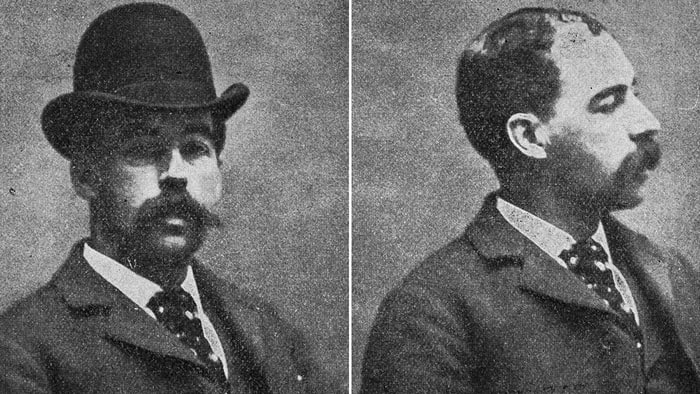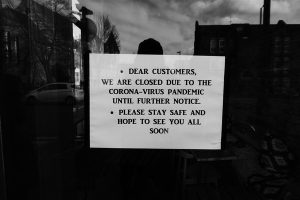Herman Webster Mudgett, commonly known as H. H. Holmes, was born in 1861 in New Hampshire.1 Mudgett was born into an affluent family and lived a very privileged life as a child. Many thought that Mudgett was unusually intelligent as a child; Mudgett showed an interest in medicine, which was one of the first signs of his psychotic behaviors, for Holmes practiced surgery on many helpless animals.2 Mudgett began his criminal life with petty acts of fraudulence and scams. One criminal act that Mudgett committed is haunting. Holmes stole corpses while as a medical student at University of Michigan in order to perform experiments on the bodies.3

Holmes later became one of America’s first serial killers. Mudgett is most commonly known for his brutal killer tactics in a specially constructed home nicknamed the “Murder Castle.” What flaws did he make? Who would commit such crimes? We are going to find out… Through criminology, specialists investigate the criminal’s mind, and acts of crime. What were the possible motives of H. H. Holmes and the flaws he made in his murders?
Mudgett was said to be an affluent, privileged child; although, there is more evidence to look for in his childhood years to show the cause of his crimes. Holmes’ mother was said to have had a terminal illness that traumatized the family. Many serial killers encounter psychological trauma early on in their life that creates a mental disorder leading to their twisted thoughts and actions. Mudgett’s mother’s illness could have been a possible cause for his psychotic behavior. Another could be that Mudgett’s mother was unable to be saved from her illness, so he wanted to join the medical field due to his hatred of doctors.
Mudgett was an extremely intelligent man, which makes him an even more terrifying figure. In 1885, Mudgett moved to Chicago and came across Elizabeth S. Holton’s drugstore at the southwest corner of South Wallace Avenue and West 63rd Street in Englewood, where he found work at a local pharmacy, and where he began using his infamous name, Dr. Henry H. Holmes.4 He worked at the pharmacy for about two years, and eventually took over the business. Holton said he proved himself to be a hardworking employee, and eventually bought the store.

With the money collected as the new owner of the local pharmacy, Holmes purchased an empty lot across from the drugstore, where construction began in 1887 on a two-story mixed-use building, with apartments on the second floor and retail spaces, including a new drugstore on the first floor.5 When Holmes declined to pay the architects or the steel company, they sued him in 1888. In 1892, he added a third floor, telling investors and suppliers that he intended to use it as a hotel during the upcoming World’s Columbian Exposition, though the hotel portion was never completed. Furniture suppliers found that Holmes was hiding their materials, for which he had never paid, in hidden rooms and passages throughout the building.6 Their search made the news, and investors for the planned hotel pulled out of the deal when a jeweler in the building showed them the articles.7 When the third floor caught fire on the night of August 13, 1893, only a few people were in the building, all employees and long-term residents. Holmes had taken out insurance policies on the building with at least four companies, all of which promptly sued rather than pay. During the 1893 Columbian Exposition, Holmes opened up his home as a hotel for visitors. Unfortunately, many guests did not survive what became known as the “Murder Castle.”8

Many of these victims were women who were seduced, lured into the “Murder Castle,” and then killed. Other victims were lured there by the offer of employment.9 Holmes did not live in Chicago for long, because many people began to catch on to his trail. With insurance companies pressing to prosecute Holmes for arson, Holmes left Chicago in July 1894 to construct another “castle” along the lines of his Chicago operation.10 If Holmes would have kept out of the many building issues of the Murder Castle, he might have been able to get away with more killings in Chicago.
In July 1894, Holmes was arrested for the first time, on the charge of selling mortgaged goods in St. Louis, Missouri.11 He was bailed out, but while in jail he met a convicted outlaw named Marion Hedgepeth, who was serving a 25-year sentence. The two planned a wild scheme to deceive an insurance company out of $10,000 by taking a policy out on Holmes and then faking his own death to receive the money. The plan became too elaborate and involved too many people, which meant a greater split of money among the group. Holmes became outraged and killed a member of the group, Benjamin Pitezel, and his entire family. Frank Geyer, a Philadelphia detective, found the decomposed bodies of the two Pitezel girls in the Pitezel house cellar after co-wrokers were suspicious that Mr. Pitezel had missed two days of work.12 After removing the bodies, Geyer noticed that one of the girl’s feet had been removed. After discovering that the girl had club foot, he theorized that the killer had cut off her feet to prevent a distinctive identification of the body.13 Holmes was reported to have visited a local pharmacy to purchase the drugs that he used to kill another member of the Pitezel family, and a repair shop to sharpen the knives he used to chop up the body before he burned it.14 The boy’s teeth and bits of bone were discovered in the home’s chimney. Holmes’ murder spree finally ended when he was arrested in Boston on November 17, 1894, after being tracked there from Philadelphia.15 In October 1895, Holmes was put on trial for the murder of Benjamin Pitezel, and was found guilty and sentenced to death.16 By then, it was evident that Holmes had also murdered the Pitezel children. Following his conviction, Holmes confessed to 27 murders in Chicago, Indianapolis, and Toronto.17 Holmes gave various contradictory accounts of his life, initially claiming innocence and later that he was possessed by Satan. On May 7, 1896, Holmes was hanged at the Philadelphia County Prison, for the murder of Pitezel family and countless other murders.18

All in all, Holmes let his impatient manner and greed get the best of him. If Holmes had been able to keep to himself, he would have been able to get away with more than he did. His motives were unclear, but the illness of his mother and his unhealthy interest in medicine have a strong correlation with the monster that was created in Chicago. Serial killers are a breed of monsters, and understanding the minds of a different breed is almost impossible. Relations and inferences can be made, but no one will ever understand why one would commit such crimes to another form of life.
- David Goldman, “Castle of Horror: The Gruesome Story of H.H. Holmes,” Biography 7, no. 5:28 (2003): 787. ↵
- David Goldman, “Castle of Horror: The Gruesome Story of H.H. Holmes,” Biography 7, no. 5:28 (2003): 789. ↵
- David Goldman, “Castle of Horror: The Gruesome Story of H.H. Holmes,” Biography 7, no. 5:28 (2003): 793. ↵
- George M. Ebehart, “New Publications,” College & Research Libraries News 64, no. 10: (2011) 680. ↵
- George M. Ebehart, “New Publications,” College & Research Libraries News 64, no. 10: (2011) 681. ↵
- George M. Ebehart, “New Publications,” College & Research Libraries News 64, no. 10: (2011) 681. ↵
- George M. Ebehart, “New Publications,” College & Research Libraries News 64, no. 10: (2011) 681. ↵
- Salem Press Encyclopedia Research Starters, 2016, s.v. “Mass and serial murders,” by Phyllis B. Gerstenfeld. ↵
- Salem Press Encyclopedia Research Starters, 2016, s.v. “Mass and serial murders,” by Phyllis B. Gerstenfeld. ↵
- Salem Press Encyclopedia Research Starters, 2016, s.v. “Mass and serial murders,” by Phyllis B. Gerstenfeld. ↵
- Salem Press Encyclopedia Research Starters, 2016, s.v. “Mass and serial murders,” by Phyllis B. Gerstenfeld. ↵
- Salem Press Encyclopedia Research Starters, 2016, s.v. “Mass and serial murders,” by Phyllis B. Gerstenfeld. ↵
- J.P. Shalloo, “Criminology,” Journal of Criminal Law and Criminology (2004), 333. ↵
- J.P. Shalloo, “Criminology,”, Journal of Criminal Law and Criminology (2004), 333. ↵
- J.P. Shalloo, “Criminology,” Journal of Criminal Law and Criminology (2004), 334. ↵
- J.P. Shalloo, “Criminology” Journal of Criminal Law and Criminology (2004), 334. ↵
- J.P. Shalloo, “Criminology,” Journal of Criminal Law and Criminology (2004), 334. ↵
- J.P. Shalloo, “Criminology,” Journal of Criminal Law and Criminology (2004), 334. ↵




92 comments
Aiden Dingle
I think that serial killers are some of the most interesting people in the world. Personally, I’m not brave enough to confront them or ask them questions but, I do like to just think about why they would murder. To see that Holmes didn’t really have a motive and that people still don’t quite know why he did what he did is really interesting. There isn’t really a pattern or reason behind his murders besides the fact that he killed them.
Peter Alva
Criminals like this always entice everyone to really want to know what was going on in someone’s head. This is why everyone likes watching those movies because it’s so crazy to think that people could do such a thing. What really amazes me is how smart these people really are, people like ted Bundy and Al Capone were people who smart and thought about what they were doing when they were doing it. this goes to show that humans are capable of doing anything with the intelligence and the will.
Caily Torres
I know of H.H Holmes from watching a variety of shows and documentaries. Holmes watched his mother die and grew a hatred for doctors because his mother was terminally ill and there was nothing they could do about it. Holmes went through a traumatic event which then resulted in not only his interest in medicine, but also his violent behavior. Holmes used these characteristics to his advantage and lure in his victims. This article was very interesting as it talked about the psychological effects that had caused Holmes to commit these horrendous murders.
Juliana Montoya
I had never heard of Holmes before this article so it was really interesting to learn about America’s first serial killer and how his “murder castle” was made. You can definitely see how smart he was and like the article said, he was very dangerous. I feel as though if he were to have gone through with the insurance plan then he would have succeeded in getting the money. The family history about him was also very interesting to learn about because you can see how the past trauma could have affected him and how he sees the world of medicine.
Pedro Pedrozo
It’s hard to imagine the thoughts that are in the head of a man who does such things. It’s even harder to think about doing those things yourself. This article really made me think about how sick one must be to do such things. H.H Holmes didn’t only kill in cold blood, he created a special place to do it in. Truly evil, but very interesting article.
Roberto Rodriguez
That is a really intriguing story to me, because it sounded like Holmes lived a normal life (or at least acted like he had one). It is crazy to think that he is America’s first serial killer, since he was not born until 1861, by the time he did his horrific crimes America was already around 100 years old. I am surprised (and relieved) that there was no serial killers in that span of time. It is grim thought that he could have not been psychotic, and that his psychotic behavior could have been as a result of his mother’s mental illness.
Sydney Hardeman
This was an interesting article. I had never heard of H.H. Holmes, or America’s first serial killer, but he seemed like a very disturbed man. Every time I read stories about these serial killers I just don’t understand how you could be so sick in the head. It is also crazy how he confessed to 27 of the murders but only 9 were confirmed.
Shea Slusser
Holmes is very likely to be one of the most hated people in america, seeming he is known as the first ever “serial killer”. These breed of monsters are always vastly more scary whenever they are known to be very intelligent. I have never heard of someone luring people into a hotel with the intention of killing them, but knowing that the Murder Castle was specifically designed for that reason, is very stomach-twisting. I am glad that Holmes was sentenced to death, and I feel for the families of his victims.
Jose De Julian
I had never heard about H.H. Holmes or what he did. He was America’s first serial killer and he would build a building in Chicago that would be known as “murder castle”. Holmes would lure people into the building and murder them. It was funny to me that he tried to fake his own death for his $10,000 insurance policy. But what was really disturbing to me was that as a child he would perform surgeries on helpless animals as well as stealing corpses from the University of Michigan.
Kathryn Martinez
What many people don’t know about Holmes is that there were many signs pointing to the development of his violent behavior. When Holmes was at the University of Michigan’s medical school, he stole several corpses from the laboratory, disfigured them, and tried to gather insurance by saying they died in an accident. He perfected these insurance scams over the years and allegedly became the beneficiary of the policies of several women who worked for him, many of whom died shortly afterward mysteriously. It just amazes me that nobody caught on to Holmes for a long long time.